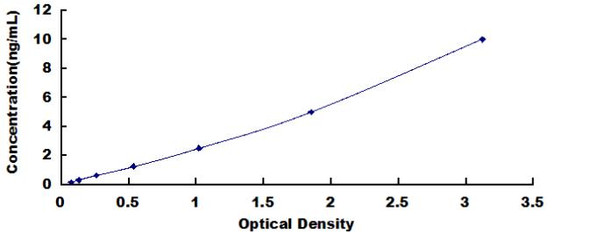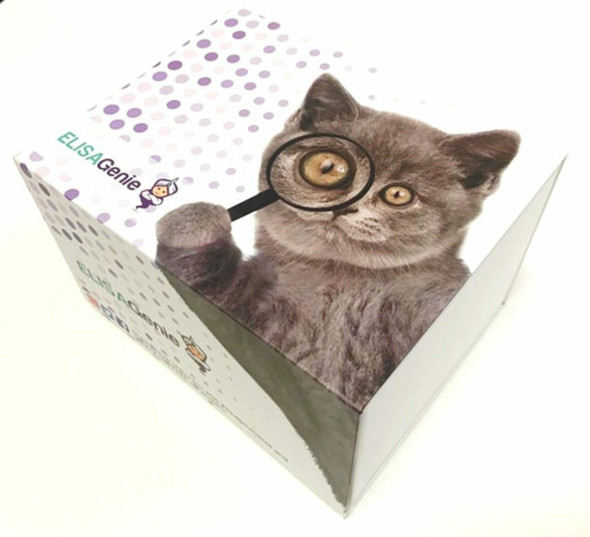Human MyD88 (Myeloid Differentiation Factor 88) ELISA Kit (HUES02906)
- SKU:
- HUES02906
- Product Type:
- ELISA Kit
- Size:
- 96 Assays
- Uniprot:
- Q99836
- Sensitivity:
- 0.09ng/mL
- Range:
- 0.16-10ng/mL
- ELISA Type:
- Sandwich
- Synonyms:
- MYD88D
- Reactivity:
- Human
- Sample Type:
- Serum, plasma and other biological fluids
- Research Area:
- Immunology
Description
Human MyD88 (Myeloid Differentiation Factor 88) ELISA Kit
The Human MYD88 (Myeloid Differentiation Factor 88) ELISA Kit is a powerful tool for detecting and quantifying MYD88 levels in human samples such as serum, plasma, and cell culture supernatants. This kit is highly sensitive and specific, providing accurate and reproducible results for a wide range of research applications.MYD88 is a key protein involved in the immune response, playing a critical role in signaling pathways that regulate inflammation and immune cell activation. Dysregulation of MYD88 has been implicated in various diseases, including autoimmune disorders, infectious diseases, and cancer.
The ability to accurately measure MYD88 levels can provide valuable insights into disease pathogenesis and facilitate the development of targeted therapies.With its high performance and versatility, the Human MYD88 ELISA Kit is an essential tool for researchers studying immune signaling pathways, inflammation, and disease mechanisms. Order now and unlock the potential of MYD88 research in your laboratory.
| Assay type: | Sandwich |
| Format: | 96T |
| Assay time: | 4.5h |
| Reactivity: | Human |
| Detection Method: | Colormetric |
| Detection Range: | 0.16-10 ng/mL |
| Sensitivity: | 0.10 ng/mL |
| Sample Volume Required Per Well: | 100µL |
| Sample Type: | Serum, plasma and other biological fluids |
| Specificity: | This kit recognizes Human MyD88 in samples. No significant cross-reactivity or interference between Human MyD88 and analogues was observed. |
This ELISA kit uses Sandwich-ELISA as the method. The micro ELISA plate provided in this kit has been pre-coated with an antibody specific to Human MyD88. Standards or samples are added to the appropriate micro ELISA plate wells and combined with the specific antibody. Then a biotinylated detection antibody specific for Human MyD88 and Avidin-Horseradish Peroxidase (HRP) conjugate are added to each micro plate well successively and incubated. Free components are washed away. The substrate solution is added to each well. Only those wells that contain Human MyD88, biotinylated detection antibody and Avidin-HRP conjugate will appear blue in color. The enzyme-substrate reaction is terminated by adding Stop Solution and the color turns yellow. The optical density (OD) is measured spectrophotometrically at a wavelength of 450 nm ± 2 nm. The OD value is proportional to the concentration of Human MyD88. The concentration of Human MyD88 in samples can be calculated by comparing the OD of the samples to the standard curve.
| UniProt Protein Function: | MYD88: Adapter protein involved in the Toll-like receptor and IL-1 receptor signaling pathway in the innate immune response. Acts via IRAK1, IRAK2, IRF7 and TRAF6, leading to NF-kappa-B activation, cytokine secretion and the inflammatory response. Increases IL-8 transcription. Involved in IL-18-mediated signaling pathway. Activates IRF1 resulting in its rapid migration into the nucleus to mediate an efficient induction of IFN-beta, NOS2/INOS, and IL12A genes. Homodimer. Also forms heterodimers with TIRAP. Binds to TLR2, TLR4, IRAK1, IRAK2 and IRAK4 via their respective TIR domains. Interacts with IL18R1. Interacts with BMX, IL1RL1 and IRF7. Interacts with LRRFIP1 and LRRFIP2; this interaction positively regulates Toll-like receptor (TLR) signaling in response to agonist. Interacts with FLII. LRRFIP1 and LRRFIP2 compete with FLII for MYD88-binding. Interacts with IRF1. Ubiquitous. 4 isoforms of the human protein are produced by alternative splicing. |
| UniProt Protein Details: | Protein type:Adaptor/scaffold Chromosomal Location of Human Ortholog: 3p22 Cellular Component: plasma membrane; endosome membrane; cytosol Molecular Function:identical protein binding; protein binding; death receptor binding Biological Process: positive regulation of interleukin-17 production; positive regulation of I-kappaB kinase/NF-kappaB cascade; nerve growth factor receptor signaling pathway; positive regulation of interleukin-23 production; positive regulation of interleukin-6 production; signal transduction; toll-like receptor 10 signaling pathway; toll-like receptor 2 signaling pathway; MyD88-dependent toll-like receptor signaling pathway; toll-like receptor 5 signaling pathway; defense response to Gram-positive bacterium; cell surface receptor linked signal transduction; regulation of inflammatory response; positive regulation of interferon type I production; toll-like receptor signaling pathway; innate immune response; toll-like receptor 9 signaling pathway; inflammatory response; toll-like receptor 4 signaling pathway; negative regulation of apoptosis Disease: Macroglobulinemia, Waldenstrom, Susceptibility To, 1; Myd88 Deficiency |
| NCBI Summary: | This gene encodes a cytosolic adapter protein that plays a central role in the innate and adaptive immune response. This protein functions as an essential signal transducer in the interleukin-1 and Toll-like receptor signaling pathways. These pathways regulate that activation of numerous proinflammatory genes. The encoded protein consists of an N-terminal death domain and a C-terminal Toll-interleukin1 receptor domain. Patients with defects in this gene have an increased susceptibility to pyogenic bacterial infections. Alternate splicing results in multiple transcript variants. [provided by RefSeq, Feb 2010] |
| UniProt Code: | Q99836 |
| NCBI GenInfo Identifier: | 18202671 |
| NCBI Gene ID: | 4615 |
| NCBI Accession: | Q99836. 1 |
| UniProt Secondary Accession: | Q99836,P78397, Q53XS7, B4DKH8, B4DKU4, B4DQ60, B4DQ72 J3KPU4, J3KQ87, J3KQJ6, |
| UniProt Related Accession: | Q99836 |
| Molecular Weight: | 34,097 Da |
| NCBI Full Name: | Myeloid differentiation primary response protein MyD88 |
| NCBI Synonym Full Names: | myeloid differentiation primary response 88 |
| NCBI Official Symbol: | MYD88 |
| NCBI Official Synonym Symbols: | MYD88D |
| NCBI Protein Information: | myeloid differentiation primary response protein MyD88; myeloid differentiation primary response gene (88) |
| UniProt Protein Name: | Myeloid differentiation primary response protein MyD88 |
| Protein Family: | Myeloid differentiation primary response protein |
| UniProt Gene Name: | MYD88 |
| UniProt Entry Name: | MYD88_HUMAN |
As the OD values of the standard curve may vary according to the conditions of the actual assay performance (e. g. operator, pipetting technique, washing technique or temperature effects), the operator should establish a standard curve for each test. Typical standard curve and data is provided below for reference only.
| Concentration (ng/mL) | O.D | Average | Corrected |
| 10 | 2.351 2.365 | 2.358 | 2.305 |
| 5 | 1.652 1.658 | 1.655 | 1.602 |
| 2.5 | 0.932 0.928 | 0.93 | 0.877 |
| 1.25 | 0.427 0.443 | 0.435 | 0.382 |
| 0.63 | 0.23 0.216 | 0.223 | 0.17 |
| 0.32 | 0.17 0.146 | 0.158 | 0.105 |
| 0.16 | 0.102 0.112 | 0.107 | 0.054 |
| 0 | 0.046 0.06 | 0.053 | -- |
Precision
Intra-assay Precision (Precision within an assay): 3 samples with low, mid range and high level Human MyD88 were tested 20 times on one plate, respectively.
Inter-assay Precision (Precision between assays): 3 samples with low, mid range and high level Human MyD88 were tested on 3 different plates, 20 replicates in each plate.
| Intra-assay Precision | Inter-assay Precision | |||||
| Sample | 1 | 2 | 3 | 1 | 2 | 3 |
| n | 20 | 20 | 20 | 20 | 20 | 20 |
| Mean (ng/mL) | 0.53 | 1.17 | 4.46 | 0.56 | 1.26 | 4.73 |
| Standard deviation | 0.03 | 0.05 | 0.20 | 0.03 | 0.06 | 0.22 |
| C V (%) | 5.66 | 4.27 | 4.48 | 5.36 | 4.76 | 4.65 |
Recovery
The recovery of Human MyD88 spiked at three different levels in samples throughout the range of the assay was evaluated in various matrices.
| Sample Type | Range (%) | Average Recovery (%) |
| Serum (n=5) | 94-108 | 100 |
| EDTA plasma (n=5) | 95-107 | 102 |
| Cell culture media (n=5) | 95-109 | 100 |
Linearity
Samples were spiked with high concentrations of Human MyD88 and diluted with Reference Standard & Sample Diluent to produce samples with values within the range of the assay.
| Serum (n=5) | EDTA plasma (n=5) | Cell culture media (n=5) | ||
| 1:2 | Range (%) | 91-103 | 85-97 | 89-102 |
| Average (%) | 98 | 91 | 96 | |
| 1:4 | Range (%) | 85-99 | 85-96 | 84-98 |
| Average (%) | 92 | 91 | 90 | |
| 1:8 | Range (%) | 86-101 | 82-95 | 84-95 |
| Average (%) | 93 | 89 | 90 | |
| 1:16 | Range (%) | 93-105 | 81-92 | 81-96 |
| Average (%) | 99 | 86 | 88 |
An unopened kit can be stored at 4°C for 1 month. If the kit is not used within 1 month, store the items separately according to the following conditions once the kit is received.
| Item | Specifications | Storage |
| Micro ELISA Plate(Dismountable) | 8 wells ×12 strips | -20°C, 6 months |
| Reference Standard | 2 vials | |
| Concentrated Biotinylated Detection Ab (100×) | 1 vial, 120 µL | |
| Concentrated HRP Conjugate (100×) | 1 vial, 120 µL | -20°C(shading light), 6 months |
| Reference Standard & Sample Diluent | 1 vial, 20 mL | 4°C, 6 months |
| Biotinylated Detection Ab Diluent | 1 vial, 14 mL | |
| HRP Conjugate Diluent | 1 vial, 14 mL | |
| Concentrated Wash Buffer (25×) | 1 vial, 30 mL | |
| Substrate Reagent | 1 vial, 10 mL | 4°C(shading light) |
| Stop Solution | 1 vial, 10 mL | 4°C |
| Plate Sealer | 5 pieces | |
| Product Description | 1 copy | |
| Certificate of Analysis | 1 copy |
- Set standard, test sample and control (zero) wells on the pre-coated plate and record theirpositions. It is recommended to measure each standard and sample in duplicate. Note: addall solutions to the bottom of the plate wells while avoiding contact with the well walls. Ensuresolutions do not foam when adding to the wells.
- Aliquot 100µl of standard solutions into the standard wells.
- Add 100µl of Sample / Standard dilution buffer into the control (zero) well.
- Add 100µl of properly diluted sample (serum, plasma, tissue homogenates and otherbiological fluids) into test sample wells.
- Cover the plate with the sealer provided in the kit and incubate for 90 min at 37°C.
- Aspirate the liquid from each well, do not wash. Immediately add 100µL of BiotinylatedDetection Ab working solution to each well. Cover the plate with a plate seal and gently mix. Incubate for 1 hour at 37°C.
- Aspirate or decant the solution from the plate and add 350µL of wash buffer to each welland incubate for 1-2 minutes at room temperature. Aspirate the solution from each well andclap the plate on absorbent filter paper to dry. Repeat this process 3 times. Note: a microplatewasher can be used in this step and other wash steps.
- Add 100µL of HRP Conjugate working solution to each well. Cover with a plate seal andincubate for 30 min at 37°C.
- Aspirate or decant the solution from each well. Repeat the wash process for five times asconducted in step 7.
- Add 90µL of Substrate Reagent to each well. Cover with a new plate seal and incubate forapproximately 15 min at 37°C. Protect the plate from light. Note: the reaction time can beshortened or extended according to the actual color change, but not by more than 30min.
- Add 50 µL of Stop Solution to each well. Note: Adding the stop solution should be done inthe same order as the substrate solution.
- Determine the optical density (OD value) of each well immediately with a microplate readerset at 450 nm.








